輕量級雲伺服器CentOS 7.3 安裝oracle11G 資料庫
適用於centos 7.3 虛擬機器 安裝 oracle 11g
(阿里雲伺服器 1G 1核)
開啟防火牆
在CentOS 7或RHEL 7或Fedora中,防火牆由FirewalID來管理
通過systemctl status firewalld檢視FirewalID狀態,發現當前是dead狀態,即防火牆未開啟。
通過systemctl start firewalld開啟防火牆,沒有任何提示即開啟成功。
執行firewall-cmd --permanent --zone=public --add-port=1521/tcp --permanent,提示success
(–permanent永久生效,沒有此引數重啟後失效)
執行firewall-cmd --reload,提示success
firewall-cmd --permanent --zone=public --list-ports
或者關閉防火牆:systemctl stop firewalld
1.設定虛擬記憶體
1.1檢視一下分割槽情況

演示:
[[email protected] ~]# free - m
total used free shared buff/cache available
Mem: 1016396 63416 806092 6644 146888 801824
Swap: 0 0 0
1.2(建立swap分割槽(我自己的伺服器記憶體只有1G、1核))
dd if=/dev/zero of=/home/swapfile bs=1M count=2048
mkswap /home/swapfile #格式化交換檔案
swapon /home/swapfile #立即啟用交換分割槽檔案, 要停止使用新建立的swap檔案,只要執行 swapoff/home/swap命令即可.
演示:
[[email protected] ~]# dd if=/dev/zero of=/home/swapfile bs=1M count=2048
2048+0 records in
2048+0 records out
2147483648 bytes (2.1 GB) copied, 15.0642 s, 143 MB/s
[ 
1.3修改 /etc/fstab
[[email protected] ~] vim /etc/fstabi 進去編輯模式
新增一行/home/swapfile swap swap defaults 0 0
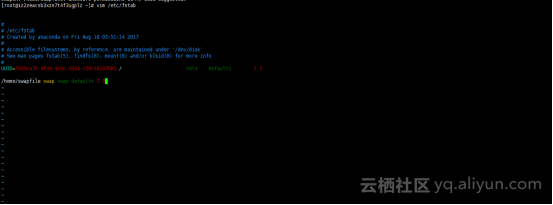
Esc 鍵 ‘:wq’ 儲存退出
1.4 檢視分割槽情況 free -m

2.安裝依賴包
安裝包參考
http://docs.oracle.com/cd/E11882_01/install.112/e24326/toc.htm#BHCCADGD
由於本次是centos 7.3系統
yum install -y binutils compat-libstdc++-33 elfutils-libelf elfutils-libelf-devel elfutils-libelf-devel-static kernel-headers glibc-headers gcc gcc-c++ glibc glibc-devel libaio libaio-devel libgcc libstdc++ libstdc++-devel libXext libXtst libX11 libXau libXi make sysstat unixODBC unixODBC-devel libXp libXp.so.6 libgomp compat-libcap1 ksh

[[email protected] ~]# yum install -y binutils compat-libstdc++-33 elfutils-libelf elfutils-libelf-devel elfutils-libelf-devel-static kernel-headers glibc-headers gcc gcc-c++ glibc glibc-devel libaio libaio-devel libgcc libstdc++ libstdc++-devel libXext libXtst libX11 libXau libXi make sysstat unixODBC unixODBC-devel libXp libXp.so.6 libgomp compat-libcap1 ksh
-- 檢視依賴包
rpm -q binutils compat-libstdc++-33 elfutils-libelf elfutils-libelf-devel glibc glibc-common glibc-devel gcc- gcc-c++ libaio-devel libaio libgcc libstdc++ libstdc++-devel make sysstat unixODBC unixODBC-devel pdksh elfutils-libelf-devel-static

[[email protected] ~]# rpm -q binutils compat-libstdc++-33 elfutils-libelf elfutils-libelf-devel glibc glibc-common glibc-devel gcc- gcc-c++ libaio-devel libaio libgcc libstdc++ libstdc++-devel make sysstat unixODBC unixODBC-devel pdksh elfutils-libelf-devel-static
3.查一下本機ip
演示:
[[email protected] ~]# ifconfig
在vim /etc/hosts檔案中新增本機IP跟主機名
[[email protected] ~]# vim /etc/hosts

Esc 鍵 ‘:wq’ 儲存退出
4.安裝解壓檔案
安裝一下yum install -y unzip zip
[[email protected] ~]# yum install -y unzip zip
5建立相關使用者和組,作為軟體安裝和支援組的擁有者。
建立Oracle使用者和密碼,輸入命令:
groupadd oinstall
groupadd dba
useradd -g oinstall -G dba -m oracle
passwd oracle
//然後會讓你輸入密碼,密碼任意輸入2次,但必須保持一致,回車確認。
演示:
[[email protected] ~]# groupadd oinstall
[[email protected] ~]# groupadd dba
[[email protected] ~]# useradd -g oinstall -G dba -m oracle
[[email protected] ~]# passwd oracle
6修改linux核心,修改/etc/sysctl.conf檔案,
輸入命令: vi /etc/sysctl.conf ,按i鍵進入編輯模式,將下列內容加入該檔案
[[email protected]n7t4f3igplz ~]# vi /etc/sysctl.conf
fs.file-max = 6815744
fs.aio-max-nr = 1048576
kernel.shmall = 2097152
kernel.shmmax = 2147483648
kernel.shmmni = 4096
kernel.sem = 250 32000 100 128
net.ipv4.ip_local_port_range = 9000 65500
net.core.rmem_default = 4194304
net.core.rmem_max = 4194304
net.core.wmem_default = 262144
net.core.wmem_max = 1048576
編輯完成後按Esc鍵,輸入“:wq”存檔退出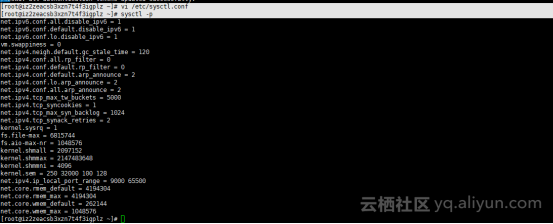
要使 /etc/sysctl.conf 更改立即生效,執行以下命令。 輸入:sysctl -p 顯示如下:
[[email protected] ~]# sysctl -p
7 修改使用者的限制檔案,編輯 vim /etc/security/limits.conf
[[email protected] ~]# Vim /etc/security/limits.conf
新增以下配置:
oracle soft nproc 2047
oracle hard nproc 16384
oracle soft nofile 1024
oracle hard nofile 65536
oracle soft stack 10240
編輯完成後按Esc鍵,輸入“:wq”存檔退出
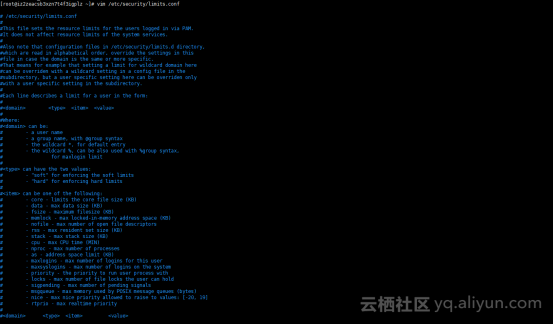
8.修改/etc/pam.d/login 檔案,輸入命令:vi /etc/pam.d/login,按i鍵進入編輯模式,將下列內容加入該檔案。
[[email protected] ~]# vim /etc/pam.d/login
新增
session required /lib/security/pam_limits.so
session required pam_limits.so
編輯完成後按Esc鍵,輸入“:wq”存檔退出
9.編輯 /etc/profile ,輸入命令:vi /etc/profile,按i鍵進入編輯模式,將下列內容加入該檔案
[[email protected] ~]# vim /etc/profile
if [ $USER = "oracle" ]; then
if [ $SHELL = "/bin/ksh" ]; then
ulimit -p 16384
ulimit -n 65536
else
ulimit -u 16384 -n 65536
fi
fi
編輯完成後按Esc鍵,輸入“:wq”存檔退出
[[email protected] ~]#source /etc/profile
10. 建立安裝目錄、修改檔案許可權
[[email protected] ~]# mkdir -p /u01/app/oracle/product/11.2.0
[[email protected] ~]# mkdir /u01/app/oracle/oradata
[[email protected] ~]# mkdir /u01/app/oracle/inventory
[[email protected] ~]# mkdir /u01/app/oracle/fast_recovery_area
[[email protected] ~]# chown -R oracle:oinstall /u01/app/oracle
[[email protected] ~]# chmod -R 775 /u01/app/oracle
11.上傳oracle軟體包到 /tmp目錄下(xftp上傳)
可在oracle 官網中下載
linux.x64_11gR2_database_1of2.zip linux.x64_11gR2_database_2of2.zip
12.解壓oracle軟體包(上傳完成後):
[[email protected] ~]# cd /tmp
[[email protected] tmp]# unzip linux.x64_11gR2_database_1of2.zip && unzip linux.x64_11gR2_database_2of2.zip
13.切換到oracle使用者,設定oracle使用者環境變數
[[email protected] ~]# su - oracle
[[email protected] ~]$ vim .bash_profile
新增:
ORACLE_BASE=/u01/app/oracle
ORACLE_HOME=$ORACLE_BASE/product/11.2.0
ORACLE_SID=orcl
PATH=$PATH:$ORACLE_HOME/bin
export ORACLE_BASE ORACLE_HOME ORACLE_SID PATH
編輯完成後按Esc鍵,輸入“:wq”存檔退出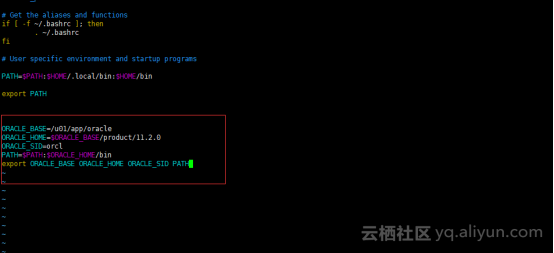
14.編輯靜默安裝響應檔案
(1)切換到root 使用者進入oracle安裝包解壓後的目錄 /tmp/database/response/下備份db_install.rsp檔案。
演示:
[[email protected] ~]# cd /tmp/database/response/
[[email protected] response]# ll
total 76
-rw-rw-r-- 1 root root 44969 Feb 14 2009 dbca.rsp
-rw-rw-r-- 1 root root 22557 Aug 15 2009 db_install.rsp
-rwxrwxr-x 1 root root 5740 Feb 26 2009 netca.rsp
[[email protected] response]# cp db_install.rsp db_install.rsp.bak
[[email protected] response]# ll
total 100
-rw-rw-r-- 1 root root 44969 Feb 14 2009 dbca.rsp
-rw-rw-r-- 1 root root 22557 Aug 15 2009 db_install.rsp
-rw-r--r-- 1 root root 22557 Nov 9 09:54 db_install.rsp.bak
-rwxrwxr-x 1 root root 5740 Feb 26 2009 netca.rsp
[[email protected] response]#
(2)編輯 /tmp/database/response/db_install.rsp檔案
[[email protected] response]# vim db_install.rsp
修改以下引數:
oracle.install.option=INSTALL_DB_SWONLY
ORACLE_HOSTNAME=iz2zeacsb3xzn7t4f3igplz
UNIX_GROUP_NAME=oinstall
INVENTORY_LOCATION=/u01/app/oracle/inventory
SELECTED_LANGUAGES=en,zh_CN
ORACLE_HOME=/u01/app/oracle/product/11.2.0
ORACLE_BASE=/u01/app/oracle
oracle.install.db.InstallEdition=EE
oracle.install.db.DBA_GROUP=dba
oracle.install.db.OPER_GROUP=dba
DECLINE_SECURITY_UPDATES=true
oracle.install.responseFileVersion=/oracle/install/rspfmt_dbinstall_response_schema_v11_2_0
oracle.install.db.isCustomInstall=false
oracle.install.db.customComponents=oracle.server:11.2.0.1.0,oracle.sysman.ccr:10.2.7.0.0,oracle.xdk:11.2.0.1.0,oracle.rdbms.oci:11.2.0.1.0,oracle.network:11.2.0.1.0,oracle.network.listener:11.2.0.1.0,oracle.rdbms:11.2.0.1.0,oracle.options:11.2.0.1.0,oracle.rdbms.partitioning:11.2.0.1.0,oracle.oraolap:11.2.0.1.0,oracle.rdbms.dm:11.2.0.1.0,oracle.rdbms.dv:11.2.0.1.0,orcle.rdbms.lbac:11.2.0.1.0,oracle.rdbms.rat:11.2.0.1.0
oracle.install.db.CLUSTER_NODES=
oracle.install.db.config.starterdb.type=GENERAL_PURPOSE
oracle.install.db.config.starterdb.globalDBName=orcl
oracle.install.db.config.starterdb.SID=orcl
oracle.install.db.config.starterdb.characterSet=AL32UTF8
oracle.install.db.config.starterdb.memoryOption=true
oracle.install.db.config.starterdb.memoryLimit=400
oracle.install.db.config.starterdb.installExampleSchemas=false
oracle.install.db.config.starterdb.enableSecuritySettings=true
oracle.install.db.config.starterdb.password.ALL=1Password
oracle.install.db.config.starterdb.password.SYS=
oracle.install.db.config.starterdb.password.SYSTEM=
oracle.install.db.config.starterdb.password.SYSMAN=
oracle.install.db.config.starterdb.password.DBSNMP=
oracle.install.db.config.starterdb.control=DB_CONTROL
oracle.install.db.config.starterdb.gridcontrol.gridControlServiceURL=
oracle.install.db.config.starterdb.dbcontrol.enableEmailNotification=false
[email protected]xxx.com
oracle.install.db.config.starterdb.dbcontrol.SMTPServer=
oracle.install.db.config.starterdb.automatedBackup.enable=false
oracle.install.db.config.starterdb.automatedBackup.osuid=
oracle.install.db.config.starterdb.automatedBackup.ospwd=
oracle.install.db.config.starterdb.storageType=FILE_SYSTEM_STORAGE
oracle.install.db.config.starterdb.fileSystemStorage.dataLocation=/u01/app/oracle/oradata
oracle.install.db.config.starterdb.fileSystemStorage.recoveryLocation=/u01/app/oracle/fast_recovery_area
oracle.install.db.config.asm.diskGroup=
oracle.install.db.config.asm.ASMSNMPPassword=
MYORACLESUPPORT_USERNAME=
MYORACLESUPPORT_PASSWORD=
SECURITY_UPDATES_VIA_MYORACLESUPPORT=
PROXY_HOST=
PROXY_PORT=
PROXY_USER=
PROXY_PWD=
15.根據響應檔案安裝oracle 11g
[[email protected] response]# su - oracle
[[email protected] ~]$ cd /tmp/database
[[email protected] database]$
[[email protected] database]$ ./runInstaller -silent -ignorePrereq -ignoreSysPrereqs -responseFile /tmp/database/response/db_install.rsp
開始Oracle在後臺靜默安裝。安裝過程中,如果提示[WARNING]不必理會,此時安裝程式仍在後臺進行,如果出現[FATAL],則安裝程式已經停止了。(可能需要一段時間才能完成)

出現以上介面,說明安裝程式已在後臺執行,此時再開啟另外一個終端選項卡,輸入提示的會話日誌目錄:
[[email protected] database]$ tail -f /home/oracle/app/oraInventory/logs/installActions2018-11-09_10-03-35AM.log
看到日誌檔案會持續輸出安裝資訊沒有輸入異常資訊,則表明安裝過程正常。

待看到下圖紅色框部分,則表明安裝已經完成
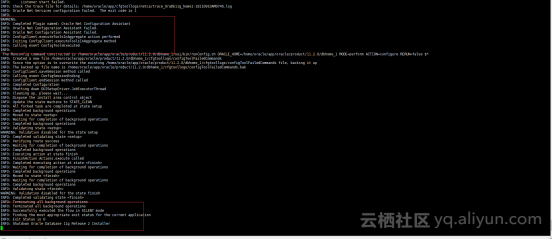
16. 按照提示切換root使用者執行指令碼
[[email protected] database]$ su - root
[[email protected] ~]# sh /u01/app/oracle/inventory/orainstRoot.sh
[[email protected] database]# sh /u01/app/oracle/product/11.2.0/root.sh

17.用oracle使用者登入配置監聽
[[email protected] ~]# su - oracle
[[email protected]~]$ netca -silent -responseFile /tmp/database/response/netca.rsp
.
.
.
出現下圖情況時,則需要配置DISPLAY變數,配完之後重新netca:
.
[[email protected] ~]$ export DISPLAY=localhost:0.0
[[email protected] ~]$ netca -silent -responseFile /tmp/database/response/netca.rsp
.
.
成功執行後,會在/u01/app/oracle/product/11.2.0/network/admin/ 中生成listener.ora和sqlnet.ora兩個檔案。
檢視監聽埠:
(如果沒有,不用著急,可在按照後重啟例項是監聽就行了)
[[email protected] admin]# netstat -tnulp | grep 1521
18. 建立新庫,同時建立對應的例項
[[email protected] ~]# cd /tmp/database/response/
[[email protected] response]# ll
total 80
-rw-rw-r-- 1 root root 44969 Feb 14 2009 dbca.rsp
-rw-rw-r-- 1 root root 2676 Nov 9 12:10 db_install.rsp
-rw-r--r-- 1 root root 22557 Nov 9 12:09 db_install.rsp.bak
-rwxrwxr-x 1 root root 5740 Feb 26 2009 netca.rsp
[[email protected] response]# cp dbca.rsp dbca.rsp.bak
切換到root使用者,編輯 /tmp/database/response/dbca.rsp
[[email protected] ~]# vim /tmp/database/response/dbca.rsp
修改以下引數(對照原來的進行修改):
##############################################################################
## ##
## DBCA response file ##
## ------------------ ##
## Copyright 1998, 2007, Oracle Corporation. All Rights Reserved. ##
## ##
## Specify values for the variables listed below to customize Oracle ##
## Database Configuration installation. ##
## ##
## Each variable is associated with a comment. The comment identifies the ##
## variable type. ##
## ##
## Please specify the values in the following format : ##
## Type : Example ##
## String : "<value>" ##
## Boolean : True or False ##
## Number : <numeric value> ##
## StringList : {"<value1>","<value2>"} ##
## ##
## Examples : ##
## 1. dbca -progress_only -responseFile <response file> ##
## Display a progress bar depicting progress of database creation ##
## process. ##
## ##
## 2. dbca -silent -responseFile <response file> ##
## Creates database silently. No user interface is displayed. ##
## ##
## 3. dbca -silent -createDatabase -cloneTemplate ##
## -responseFile <response file> ##
## Creates database silently with clone template. The template in ##
## responsefile is a clone template. ##
## ##
## 4. dbca -silent -deleteDatabase -responseFile <response file> ##
## Deletes database silently. ##
##############################################################################
#-----------------------------------------------------------------------------
# GENERAL section is required for all types of database creations.
#-----------------------------------------------------------------------------
[GENERAL]
#-----------------------------------------------------------------------------
# Name : RESPONSEFILE_VERSION
# Datatype : String
# Description : Version of the database to create
# Valid values : "11.1.0"
# Default value : None
# Mandatory : Yes
#-----------------------------------------------------------------------------
RESPONSEFILE_VERSION = "11.2.0"
#-----------------------------------------------------------------------------
# Name : OPERATION_TYPE
# Datatype : String
# Description : Type of operation
# Valid values : "createDatabase" \ "createTemplateFromDB" \ "createCloneTemplate" \ "deleteDatabase" \ "configureDatabase" \ "addInstance" (RAC-only) \ "deleteInstance" (RAC-only)
# Default value : None
# Mandatory : Yes
#-----------------------------------------------------------------------------
OPERATION_TYPE = "createDatabase"
#-----------------------*** End of GENERAL section ***------------------------
#-----------------------------------------------------------------------------
# CREATEDATABASE section is used when OPERATION_TYPE is defined as "createDatabase".
#-----------------------------------------------------------------------------
[CREATEDATABASE]
#-----------------------------------------------------------------------------
# Name : GDBNAME
# Datatype : String
# Description : Global database name of the database
# Valid values : <db_name>.<db_domain> - when database domain isn't NULL
# <db_name> - when database domain is NULL
# Default value : None
# Mandatory : Yes
#-----------------------------------------------------------------------------
GDBNAME = "orcl"
#-----------------------------------------------------------------------------
# Name : POLICYMANAGED
# Datatype : Boolean
# Description : Set to true if Database is policy managed and
# set to false if Database is admin managed
# Valid values : TRUE\FALSE
# Default value : FALSE
# Mandatory : No
#-----------------------------------------------------------------------------
#POLICYMANAGED = "false"
#-----------------------------------------------------------------------------
# Name : CREATESERVERPOOL
# Datatype : Boolean
# Description : Set to true if new server pool need to be created for database
# if this option is specified then the newly created database
# will use this newly created serverpool.
# Multiple serverpoolname can not be specified for database
# Valid values : TRUE\FALSE
# Default value : FALSE
# Mandatory : No
#-----------------------------------------------------------------------------
#CREATESERVERPOOL = "false"
#-----------------------------------------------------------------------------
# Name : FORCE
# Datatype : Boolean
# Description : Set to true if new server pool need to be created by force
# if this option is specified then the newly created serverpool
# will be assigned server even if no free servers are available.
# This may affect already running database.
# This flag can be specified for Admin managed as well as policy managed db.
# Valid values : TRUE\FALSE
# Default value : FALSE
# Mandatory : No
#-----------------------------------------------------------------------------
#FORCE = "false"
#-----------------------------------------------------------------------------
# Name : SERVERPOOLNAME
# Datatype : String
# Description : Only one serverpool name need to be specified
# if Create Server Pool option is specified.
# Comma-separated list of Serverpool names if db need to use
# multiple Server pool
# Valid values : ServerPool name
# Default value : None
# Mandatory : No [required in case of RAC service centric database]
#-----------------------------------------------------------------------------
#SERVERPOOLNAME =
#-----------------------------------------------------------------------------
# Name : CARDINALITY
# Datatype : Number
# Description : Specify Cardinality for create server pool operation
# Valid values : any positive Integer value
# Default value : Number of qualified nodes on cluster
# Mandatory : No [Required when a new serverpool need to be created]
#-----------------------------------------------------------------------------
#CARDINALITY =
#-----------------------------------------------------------------------------
# Name : SID
# Datatype : String
# Description : System identifier (SID) of the database
# Valid values : Check Oracle11g Administrator's Guide
# Default value : <db_name> specified in GDBNAME
# Mandatory : No
#-----------------------------------------------------------------------------
SID = "orcl"
#-----------------------------------------------------------------------------
# Name : NODELIST
# Datatype : String
# Description : Comma-separated list of cluster nodes
# Valid values : Cluster node names
# Default value : None
# Mandatory : No (Yes for RAC database-centric database )
#-----------------------------------------------------------------------------
#NODELIST=
#-----------------------------------------------------------------------------
# Name : TEMPLATENAME
# Datatype : String
# Description : Name of the template
# Valid values : Template file name
# Default value : None
# Mandatory : Yes
#-----------------------------------------------------------------------------
TEMPLATENAME = "General_Purpose.dbc"
#-----------------------------------------------------------------------------
# Name : OBFUSCATEDPASSWORDS
# Datatype : Boolean
# Description : Set to true if passwords are encrypted
# Valid values : TRUE\FALSE
# Default value : FALSE
# Mandatory : No
#-----------------------------------------------------------------------------
#OBFUSCATEDPASSWORDS = FALSE
#-----------------------------------------------------------------------------
# Name : SYSPASSWORD
# Datatype : String
# Description : Password for SYS user
# Valid values : Check Oracle11g Administrator's Guide
# Default value : None
# Mandatory : Yes
#-----------------------------------------------------------------------------
SYSPASSWORD = "oracle"
#-----------------------------------------------------------------------------
# Name : SYSTEMPASSWORD
# Datatype : String
# Description : Password for SYSTEM user
# Valid values : Check Oracle11g Administrator's Guide
# Default value : None
# Mandatory : Yes
#-----------------------------------------------------------------------------
SYSTEMPASSWORD = "oracle"
#-----------------------------------------------------------------------------
# Name : EMCONFIGURATION
# Datatype : String
# Description : Enterprise Manager Configuration Type
# Valid values : CENTRAL|LOCAL|ALL|NOBACKUP|NOEMAIL|NONE
# Default value : NONE
# Mandatory : No
#-----------------------------------------------------------------------------
#EMCONFIGURATION = "NONE"
#-----------------------------------------------------------------------------
# Name : DISABLESECURITYCONFIGURATION
# Datatype : String
# Description : Database Security Settings
# Valid values : ALL|NONE|AUDIT|PASSWORD_PROFILE
# Default value : NONE
# Mandatory : No
#-----------------------------------------------------------------------------
#DISABLESECURITYCONFIGURATION = "NONE"
#-----------------------------------------------------------------------------
# Name : SYSMANPASSWORD
# Datatype : String
# Description : Password for SYSMAN user
# Valid values : Check Oracle11g Administrator's Guide
# Default value : None
# Mandatory : Yes, if LOCAL specified for EMCONFIGURATION
#-----------------------------------------------------------------------------
#SYSMANPASSWORD = "password"
#-----------------------------------------------------------------------------
# Name : DBSNMPPASSWORD
# Datatype : String
# Description : Password for DBSNMP user
# Valid values : Check Oracle11g Administrator's Guide
# Default value : None
# Mandatory : Yes, if EMCONFIGURATION is specified
#-----------------------------------------------------------------------------
DBSNMPPASSWORD = "oracle"
#-----------------------------------------------------------------------------
# Name : CENTRALAGENT
# Datatype : String
# Description : Grid Control Central Agent Oracle Home
# Default value : None
# Mandatory : Yes, if CENTRAL is specified for EMCONFIGURATION
#-----------------------------------------------------------------------------
#CENTRALAGENT =
#-----------------------------------------------------------------------------
# Name : HOSTUSERNAME
# Datatype : String
# Description : Host user name for EM backup job
# Default value : None
# Mandatory : Yes, if ALL or NOEMAIL are specified for EMCONFIGURATION
#-----------------------------------------------------------------------------
#HOSTUSERNAME =
#-----------------------------------------------------------------------------
# Name : HOSTUSERPASSWORD
# Datatype : String
# Description : Host user password for EM backup job
# Default value : None
# Mandatory : Yes, if ALL or NOEMAIL are specified for EMCONFIGURATION
#-----------------------------------------------------------------------------
#HOSTUSERPASSWORD=
#-----------------------------------------------------------------------------
# Name : BACKUPSCHEDULE
# Datatype : String
# Description : Daily backup schedule in the form of hh:mm
# Default value : 2:00
# Mandatory : Yes, if ALL or NOEMAIL are specified for EMCONFIGURATION
#-----------------------------------------------------------------------------
#BACKUPSCHEDULE=
#-----------------------------------------------------------------------------
# Name : SMTPSERVER
# Datatype : String
# Description : Outgoing mail (SMTP) server for email notifications
# Default value : None
# Mandatory : Yes, if ALL or NOBACKUP are specified for EMCONFIGURATION
#-----------------------------------------------------------------------------
#SMTPSERVER =
#-----------------------------------------------------------------------------
# Name : EMAILADDRESS
# Datatype : String
# Description : Email address for email notifications
# Default value : None
# Mandatory : Yes, if ALL or NOBACKUP are specified for EMCONFIGURATION
#-----------------------------------------------------------------------------
#EMAILADDRESS =
#-----------------------------------------------------------------------------
# Name : DVOWNERNAME
# Datatype : String
# Description : DataVault Owner
# Valid values : Check Oracle11g Administrator's Guide
# Default value : None
# Mandatory : Yes, if DataVault option is chosen
#-----------------------------------------------------------------------------
#DVOWNERNAME = ""
#-----------------------------------------------------------------------------
# Name : DVOWNERPASSWORD
# Datatype : String
# Description : Password for DataVault Owner
# Valid values : Check Oracle11g Administrator's Guide
# Default value : None
# Mandatory : Yes, if DataVault option is chosen
#-----------------------------------------------------------------------------
#DVOWNERPASSWORD = ""
#-----------------------------------------------------------------------------
# Name : DVACCOUNTMANAGERNAME
# Datatype : String
# Description : DataVault Account Manager
# Valid values : Check Oracle11g Administrator's Guide
# Default value : None
# Mandatory : No
#-----------------------------------------------------------------------------
#DVACCOUNTMANAGERNAME = ""
#-----------------------------------------------------------------------------
# Name : DVACCOUNTMANAGERPASSWORD
# Datatype : String
# Description : Password for DataVault Account Manager
# Valid values : Check Oracle11g Administrator's Guide
# Default value : None
# Mandatory : No
#-----------------------------------------------------------------------------
#DVACCOUNTMANAGERPASSWORD = ""
#-----------------------------------------------------------------------------
# Name : DATAFILEJARLOCATION
# Datatype : String
# Description : Location of the data file jar
# Valid values : Directory containing compressed datafile jar
# Default value : None
# Mandatory : No
#-----------------------------------------------------------------------------
#DATAFILEJARLOCATION =
#-----------------------------------------------------------------------------
# Name : DATAFILEDESTINATION
# Datatype : String
# Description : Location of the data file's
# Valid values : Directory for all the database files
# Default value : $ORACLE_BASE/oradata
# Mandatory : No
#-----------------------------------------------------------------------------
DATAFILEDESTINATION = /u01/app/oracle/oradata
#-----------------------------------------------------------------------------
# Name : RECOVERYAREADESTINATION
# Datatype : String
# Description : Location of the data file's
# Valid values : Recovery Area location
# Default value : $ORACLE_BASE/flash_recovery_area
# Mandatory : No
#-----------------------------------------------------------------------------
RECOVERYAREADESTINATION= /u01/app/oracle/fast_recovery_area
#-----------------------------------------------------------------------------
# Name : STORAGETYPE
# Datatype : String
# Description : Specifies the storage on which the database is to be created
# Valid values : FS (CFS for RAC), ASM
# Default value : FS
# Mandatory : No
#-----------------------------------------------------------------------------
#STORAGETYPE=FS
#-----------------------------------------------------------------------------
# Name : DISKGROUPNAME
# Datatype : String
# Description : Specifies the disk group name for the storage
# Default value : DATA
# Mandatory : No
#-----------------------------------------------------------------------------
#DISKGROUPNAME=DATA
#-----------------------------------------------------------------------------
# Name : ASMSNMP_PASSWORD
# Datatype : String
# Description : Password for ASM Monitoring
# Default value : None
# Mandatory : No
#-----------------------------------------------------------------------------
#ASMSNMP_PASSWORD=""
#-----------------------------------------------------------------------------
# Name : RECOVERYGROUPNAME
# Datatype : String
# Description : Specifies the disk group name for the recovery area
# Default value : RECOVERY
# Mandatory : No
#-----------------------------------------------------------------------------
#RECOVERYGROUPNAME=RECOVERY
#-----------------------------------------------------------------------------
# Name : CHARACTERSET
# Datatype : String
# Description : Character set of the database
# Valid values : Check Oracle11g National Language Support Guide
# Default value : "US7ASCII"
# Mandatory : NO
#-----------------------------------------------------------------------------
CHARACTERSET = "ZHS16GBK"
#-----------------------------------------------------------------------------
# Name : NATIONALCHARACTERSET
# Datatype : String
# Description : National Character set of the database
# Valid values : "UTF8" or "AL16UTF16". For details, check Oracle11g National Language Support Guide
# Default value : "AL16UTF16"
# Mandatory : No
#-----------------------------------------------------------------------------
#NATIONALCHARACTERSET= "UTF8"
#-----------------------------------------------------------------------------
# Name : REGISTERWITHDIRSERVICE
# Datatype : Boolean
# Description : Specifies whether to register with Directory Service.
# Valid values : TRUE \ FALSE
# Default value : FALSE
# Mandatory : No
#-----------------------------------------------------------------------------
#REGISTERWITHDIRSERVICE= TRUE
#-----------------------------------------------------------------------------
# Name : DIRSERVICEUSERNAME
# Datatype : String
# Description : Specifies the name of the directory service user
# Mandatory : YES, if the value of registerWithDirService is TRUE
#-----------------------------------------------------------------------------
#DIRSERVICEUSERNAME= "name"
#-----------------------------------------------------------------------------
# Name : DIRSERVICEPASSWORD
# Datatype : String
# Description : The password of the directory service user.
# You can also specify the password at the command prompt instead of here.
# Mandatory : YES, if the value of registerWithDirService is TRUE
#-----------------------------------------------------------------------------
#DIRSERVICEPASSWORD= "password"
#-----------------------------------------------------------------------------
# Name : WALLETPASSWORD
# Datatype : String
# Description : The password for wallet to created or modified.
# You can also specify the password at the command prompt instead of here.
# Mandatory : YES, if the value of registerWithDirService is TRUE
#-----------------------------------------------------------------------------
#WALLETPASSWORD= "password"
#-----------------------------------------------------------------------------
# Name : LISTENERS
# Datatype : String
# Description : Specifies list of listeners to register the database with.
# By default the database is configured for all the listeners specified in the
# $ORACLE_HOME/network/admin/listener.ora
# Valid values : The list should be space separated names like "listener1 listener2".
# Mandatory : NO
#-----------------------------------------------------------------------------
#LISTENERS = "listener1 listener2"
#-----------------------------------------------------------------------------
# Name : VARIABLESFILE
# Datatype : String
# Description : Location of the file containing variable value pair
# Valid values : A valid file-system file. The variable value pair format in this file
# is <variable>=<value>. Each pair should be in a new line.
# Default value : None
# Mandatory : NO
#-----------------------------------------------------------------------------
#VARIABLESFILE =
#-----------------------------------------------------------------------------
# Name : VARIABLES
# Datatype : String
# Description : comma separated list of name=value pairs. Overrides variables defined in variablefile and templates
# Default value : None
# Mandatory : NO
#-----------------------------------------------------------------------------
#VARIABLES =
#-----------------------------------------------------------------------------
# Name : INITPARAMS
# Datatype : String
# Description : comma separated list of name=value pairs. Overrides initialization parameters defined in templates
# Default value : None
# Mandatory : NO
#-----------------------------------------------------------------------------
#INITPARAMS =
#-----------------------------------------------------------------------------
# Name : MEMORYPERCENTAGE
# Datatype : String
# Description : percentage of physical memory for Oracle
# Default value : None
# Mandatory : NO
#-----------------------------------------------------------------------------
#MEMORYPERCENTAGE = "40"
#-----------------------------------------------------------------------------
# Name : DATABASETYPE
# Datatype : String
# Description : used for memory distribution when MEMORYPERCENTAGE specified
# Valid values : MULTIPURPOSE|DATA_WAREHOUSING|OLTP
# Default value : MULTIPURPOSE
# Mandatory : NO
#-----------------------------------------------------------------------------
#DATABASETYPE = "MULTIPURPOSE"
#-----------------------------------------------------------------------------
# Name : AUTOMATICMEMORYMANAGEMENT
# Datatype : Boolean
# Description : flag to indicate Automatic Memory Management is used
# Valid values : TRUE/FALSE
# Default value : TRUE
# Mandatory : NO
#-----------------------------------------------------------------------------
#AUTOMATICMEMORYMANAGEMENT = "TRUE"
#-----------------------------------------------------------------------------
# Name : TOTALMEMORY
# Datatype : String
# Description : total memory in MB to allocate to Oracle
# Valid values :
# Default value :
# Mandatory : NO
#-----------------------------------------------------------------------------
TOTALMEMORY = "1638"
#-----------------------*** End of CREATEDATABASE section ***------------------------
#-----------------------------------------------------------------------------
# createTemplateFromDB section is used when OPERATION_TYPE is defined as "createTemplateFromDB".
#-----------------------------------------------------------------------------
[createTemplateFromDB]
#-----------------------------------------------------------------------------
# Name : SOURCEDB
# Datatype : String
# Description : The source database from which to create the template
# Valid values : The format is <host>:<port>:<sid>
# Default value : none
# Mandatory : YES
#-----------------------------------------------------------------------------
SOURCEDB = "myhost:1521:orcl"
#-----------------------------------------------------------------------------
# Name : SYSDBAUSERNAME
# Datatype : String
# Description : A user with DBA role.
# Default value : none
# Mandatory : YES
#-----------------------------------------------------------------------------
SYSDBAUSERNAME = "system"
#-----------------------------------------------------------------------------
# Name : SYSDBAPASSWORD
# Datatype : String
# Description : The password of the DBA user.
# You can also specify the password at the command prompt instead of here.
# Default value : none
# Mandatory : YES
#-----------------------------------------------------------------------------
#SYSDBAPASSWORD = "password"
#-----------------------------------------------------------------------------
# Name : TEMPLATENAME
# Datatype : String
# Description : Name for the new template.
# Default value : None
# Mandatory : Yes
#-----------------------------------------------------------------------------
TEMPLATENAME = "My Copy TEMPLATE"
#-----------------------*** End of createTemplateFromDB section ***------------------------
#-----------------------------------------------------------------------------
# createCloneTemplate section is used when OPERATION_TYPE is defined as "createCloneTemplate".
#-----------------------------------------------------------------------------
[createCloneTemplate]
#-----------------------------------------------------------------------------
# Name : SOURCEDB
# Datatype : String
# Description : The source database is the SID from which to create the template.
# This database must be local and on the same ORACLE_HOME.
# Default value : none
# Mandatory : YES
#-----------------------------------------------------------------------------
SOURCEDB = "orcl"
#-----------------------------------------------------------------------------
# Name : SYSDBAUSERNAME
# Datatype : String
# Description : A user with DBA role.
# Default value : none
# Mandatory : YES, if no OS authentication
#-----------------------------------------------------------------------------
#SYSDBAUSERNAME = "sys"
#-----------------------------------------------------------------------------
# Name : SYSDBAPASSWORD
# Datatype : String
# Description : The password of the DBA user.
# You can also specify the password at the command prompt instead of here.
# Default value : none
# Mandatory : YES
#-----------------------------------------------------------------------------
#SYSDBAPASSWORD = "password"
#-----------------------------------------------------------------------------
# Name : TEMPLATENAME
# Datatype : String
# Description : Name for the new template.
# Default value : None
# Mandatory : Yes
#-----------------------------------------------------------------------------
TEMPLATENAME = "My Clone TEMPLATE"
#-----------------------------------------------------------------------------
# Name : DATAFILEJARLOCATION
# Datatype : String
# Description : Location of the data file jar
# Valid values : Directory where the new compressed datafile jar will be placed
# Default value : $ORACLE_HOME/assistants/dbca/templates
# Mandatory : NO
#-----------------------------------------------------------------------------
#DATAFILEJARLOCATION =
#-----------------------*** End of createCloneTemplate section ***------------------------
#-----------------------------------------------------------------------------
# DELETEDATABASE section is used when DELETE_TYPE is defined as "deleteDatabase".
#-----------------------------------------------------------------------------
[DELETEDATABASE]
#-----------------------------------------------------------------------------
# Name : SOURCEDB
# Datatype : String
# Description : The source database is the SID
# This database must be local and on the same ORACLE_HOME.
# Default value : none
# Mandatory : YES
#-----------------------------------------------------------------------------
SOURCEDB = "orcl"
#-----------------------------------------------------------------------------
# Name : SYSDBAUSERNAME
# Datatype : String
# Description : A user with DBA role.
# Default value : none
# Mandatory : YES, if no OS authentication
#-----------------------------------------------------------------------------
#SYSDBAUSERNAME = "sys"
#-----------------------------------------------------------------------------
# Name : SYSDBAPASSWORD
# Datatype : String
# Description : The password of the DBA user.
# You can also specify the password at the command prompt instead of here.
# Default value : none
# Mandatory : YES, if no OS authentication
#-----------------------------------------------------------------------------
#SYSDBAPASSWORD = "password"
#-----------------------*** End of deleteDatabase section ***------------------------
#-----------------------------------------------------------------------------
# GENERATESCRIPTS section
#-----------------------------------------------------------------------------
[generateScripts]
#-----------------------------------------------------------------------------
# Name : TEMPLATENAME
# Datatype : String
# Description : Name of the template
# Valid values : Template name as seen in DBCA
# Default value : None
# Mandatory : Yes
#-----------------------------------------------------------------------------
TEMPLATENAME = "New Database"
#-----------------------------------------------------------------------------
# Name : GDBNAME
# Datatype : String
# Description : Global database name of the database
# Valid values : <db_name>.<db_domain> - when database domain isn't NULL
# <db_name> - when database domain is NULL
# Default value : None
# Mandatory : Yes
#-----------------------------------------------------------------------------
GDBNAME = "orcl"
#-----------------------------------------------------------------------------
# Name : SCRIPTDESTINATION
# Datatype : String
# Description : Location of the scripts
# Valid values : Directory for all the scripts
# Default value : None
# Mandatory : No
#-----------------------------------------------------------------------------
#SCRIPTDESTINATION =
#-----------------------*** End of deleteDatabase section ***------------------------
#-----------------------------------------------------------------------------
# CONFIGUREDATABASE section is used when OPERATION_TYPE is defined as "configureDatabase".
#-----------------------------------------------------------------------------
[CONFIGUREDATABASE]
#-----------------------------------------------------------------------------
# Name : SOURCEDB
# Datatype : String
# Description : The source database is the SID
# This database must be local and on the same ORACLE_HOME.
# Default value : none
# Mandatory : YES
#-----------------------------------------------------------------------------
#SOURCEDB = "orcl"
#-----------------------------------------------------------------------------
# Name : SYSDBAUSERNAME
# Datatype : String
# Description : A user with DBA role.
# Default value : none
# Mandatory : YES, if no OS authentication
#-----------------------------------------------------------------------------
#SYSDBAUSERNAME = "sys"
#-----------------------------------------------------------------------------
# Name : SYSDBAPASSWORD
# Datatype : String
# Description : The password of the DBA user.
# You can also specify the password at the command prompt instead of here.
# Default value : none
# Mandatory : YES, if no OS authentication
#-----------------------------------------------------------------------------
#SYSDBAPASSWORD =
#-----------------------------------------------------------------------------
# Name : REGISTERWITHDIRSERVICE
# Datatype : Boolean
# Description : Specifies whether to register with Directory Service.
# Valid values : TRUE \ FALSE
# Default value : FALSE
# Mandatory : No
#-----------------------------------------------------------------------------
#REGISTERWITHDIRSERVICE= TRUE
#-----------------------------------------------------------------------------
# Name : UNREGISTERWITHDIRSERVICE
# Datatype : Boolean
# Description : Specifies whether to unregister with Directory Service.
# Valid values : TRUE \ FALSE
# Default value : FALSE
# Mandatory : No
#-----------------------------------------------------------------------------
#UNREGISTERWITHDIRSERVICE= TRUE
#-----------------------------------------------------------------------------
# Name : REGENERATEDBPASSWORD
# Datatype : Boolean
# Description : Specifies whether regenerate database password in OID/Wallet
# Valid values : TRUE \ FALSE
# Default value : FALSE
# Mandatory : No
#-----------------------------------------------------------------------------
#REGENERATEDBPASSWORD= TRUE
#-----------------------------------------------------------------------------
# Name : DIRSERVICEUSERNAME
# Datatype : String
# Description : Specifies the name of the directory service user
# Mandatory : YES, if the any of the reg/unreg/regenPasswd options specified
#-----------------------------------------------------------------------------
#DIRSERVICEUSERNAME= "name"
#-----------------------------------------------------------------------------
# Name : DIRSERVICEPASSWORD
# Datatype : String
# Description : The password of the directory service user.
# You can also specify the password at the command prompt instead of here.
# Mandatory : YES, if the any of the reg/unreg/regenPasswd options specified
#-----------------------------------------------------------------------------
#DIRSERVICEPASSWORD= "password"
#-----------------------------------------------------------------------------
# Name : WALLETPASSWORD
# Datatype : String
# Description : The password for wallet to created or modified.
# You can also specify the password at the command prompt instead of here.
# Mandatory : YES, if the any of the reg/unreg/regenPasswd options specified
#-----------------------------------------------------------------------------
#WALLETPASSWORD= "password"
#-----------------------------------------------------------------------------
# Name : DISABLESECURITYCONFIGURATION
# Datatype : String
# Description : Database Security Settings
# Valid values : ALL|NONE|AUDIT|PASSWORD_PROFILE
# Default value : NONE
# Mandatory : No
#-----------------------------------------------------------------------------
#DISABLESECURITYCONFIGURATION = "NONE"
#-----------------------------------------------------------------------------
# Name : ENABLESECURITYCONFIGURATION
# Datatype : String
# Description : Database Security Settings
# Valid values : true|false
# Default value : true
# Mandatory : No
#-----------------------------------------------------------------------------
#ENABLESECURITYCONFIGURATION = "true"
#-----------------------------------------------------------------------------
# Name : EMCONFIGURATION
# Datatype : String
# Description : Enterprise Manager Configuration Type
# Valid values : CENTRAL|LOCAL|ALL|NOBACKUP|NOEMAIL|NONE
# Default value : NONE
# Mandatory : No
#-----------------------------------------------------------------------------
#EMCONFIGURATION = "NONE"
#-----------------------------------------------------------------------------
# Name : SYSMANPASSWORD
# Datatype : String
# Description : Password for SYSMAN user
# Valid values : Check Oracle11g Administrator's Guide
# Default value : None
# Mandatory : Yes, if LOCAL specified for EMCONFIGURATION
#-----------------------------------------------------------------------------
SYSMANPASSWORD = "oracle"
#-----------------------------------------------------------------------------
# Name : DBSNMPPASSWORD
# Datatype : String
# Description : Password for DBSNMP user
# Valid values : Check Oracle11g Administrator's Guide
# Default value : None
# Mandatory : Yes, if EMCONFIGURATION is specified
#-----------------------------------------------------------------------------
#DBSNMPPASSWORD = "password"
#-----------------------------------------------------------------------------
# Name : CENTRALAGENT
# Datatype : String
# Description : Grid Control Central Agent Oracle Home
# Default value : None
# Mandatory : Yes, if CENTRAL is specified for EMCONFIGURATION
#-----------------------------------------------------------------------------
#CENTRALAGENT =
#-----------------------------------------------------------------------------
# Name : HOSTUSERNAME
# Datatype : String
# Description : Host user name for EM backup job
# Default value : None
# Mandatory : Yes, if ALL or NOEMAIL are specified for EMCONFIGURATION
#-----------------------------------------------------------------------------
#HOSTUSERNAME =
#-----------------------------------------------------------------------------
# Name : HOSTUSERPASSWORD
# Datatype : String
# Description : Host user password for EM backup job
# Default value : None
# Mandatory : Yes, if ALL or NOEMAIL are specified for EMCONFIGURATION
#-----------------------------------------------------------------------------
#HOSTUSERPASSWORD=
#-----------------------------------------------------------------------------
# Name : BACKUPSCHEDULE
# Datatype : String
# Description : Daily backup schedule in the form of hh:mm
# Default value : 2:00
# Mandatory : Yes, if ALL or NOEMAIL are specified for EMCONFIGURATION
#-----------------------------------------------------------------------------
#BACKUPSCHEDULE=
#-----------------------------------------------------------------------------
# Name : SMTPSERVER
# Datatype : String
# Description : Outgoing mail (SMTP) server for email notifications
# Default value : None
# Mandat
